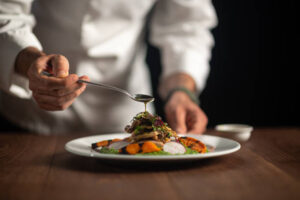Imagine a chef cooking a meal and every ingredient’s past playing before their eyes. That is the food service of today—more akin to detective work than traditional cooking. Will that bit of fish survive the rising ocean temperature? Is the tomato in the salad traceable to a farm free of pesticides? These are not questions with random answers. Diners want answers, hence eateries are trying to keep up. Discover on Lianne Wadi.

Green ideas have exploded on menus all around. Sustainability has crept into the fine linens of luxury hotels and fast-paced businesses both, not only the preserve of crunchy granola cafes. Part of the new hospitality mix is composting, local sourcing, energy-efficient appliances. Now Fair Trade, shade-grown, and scooped from a reusable jar might apply even to the most basic cup of coffee.
One also finds money on the table. Food waste alone expenses companies billions of dollars annually. Kitchens are now computing everything from carrot top to root, extracting value from once thrown-off trash. One chef claimed to have visitors raving and scratching their heads from his carrot brisket. ” Likes Sunday dinner,” one said. “I can’t believe it’s veggie,” another said.
It involves more than simply leftovers. All around there is tremendous pressure. Guests search for supplies on Google. Review websites draw attention to waste. Employees want more environmentally friendly uniforms. Try avoiding vegetarian choices on Mondays; you might hear a collective groan—or worse—or be lampooned on social media. That vegan sausage suddenly has gold’s weight worth.
Global events have also gently pushed the sector. Changing weather makes farming a wild game. While storms wipe off crop prospects overnight, sudden droughs drive avocado prices skyward. Restaurants turn around and instantly change menus. When the special vanishes from yesterday, diners hardly blink: “Whatever’s freshest, I’m in!” Not knowing what the chef will create next excites one strangely.
Some operators laugh, believing this to be only a trend. But let us review the scoreboard. According to a recent research, half of millennial consumers choose locations based just on environmental credentials. Trust is earned; it is not automatic; so, every compost bin, LED bulb, or recycled napkin helps create that credit—call it what you wish. Ignore the momentum; you run the danger of presenting news from yesterday.
Neither does the narrative end at the plate. Hotels get bad marks for single-use shampoos. Buffets are measured servings, not limitless mountains of food these days. And the closet used for cleaning? Not harsh chemicals; instead, loaded with plant-based sprays “If my hotel smells like fresh lemons and not bleach, I’m more likely to come back,” laughed a regular visitor at breakfast recently.
Maybe the most unexpected turn is this. Often, being green pulls the team together. Chefs get close over urban foraging. Servers discuss water saving with managers. The washing machine? He feels good about monitoring low-flow machine energy savings. You would be astonished at the friendship that results from trading metal for plastic straws.
Consumers, meantime, no longer find value in hollow promises. The luxury of today is transparency. QR codes lead to tales of farming. Menus describe beginnings. The rear kitchen is no place for hiding now.
Sustainability is baked in food service and hospitality; it is not a passing trend. It is always there, influencing the tastes and experience like a pot simmering on the rear burner. Whether you’re serving flinging sub sandwiches or exquisite dining, operations that can mix great cuisine with a smaller impact will shape the future. Leave the greenwashing behind; this movement is about presenting the actual thing.